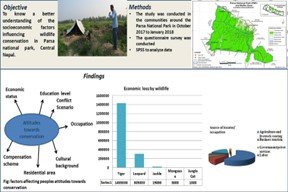Socioeconomic status of the people and their attitude toward conservation in Parsa National Park, Nepal
Abstract
This study aims to investigate the socioeconomic status of communities living in proximity to a park and their attitudes towards conservation. The questionnaires used in this study were carefully designed to achieve the desired research objectives. The majority of people living adjacent to the park depend on agriculture and livestock farming for their livelihood. People also benefit from the forest's resources in many aspects. People’s perceptions of wildlife conservation vary widely and are influenced by various factors such as economic status, cultural background, education status, awareness level, and personal experiences. Respondents with higher education status have been found to exhibit positive attitudes towards conservation. Results have shown that 70% of respondents who live near the park claim that coexistence with wildlife is becoming increasingly problematic. While the respondents are pleased with the practical conservation strategies that have contributed to the rise in wildlife populations, they are concerned about the increasing conflicts with wildlife. Crop raiding is a serious problem in several villages located near dense forests. Livestock depredation is another major issue that has been observed in the same area. Wildlife has been known to attack and kill livestock, causing a significant loss of income for the farmers in these villages. Many people feel that the lack of effective compensation mechanisms has led to a sense of antagonism towards both authorities and conservation efforts as a whole. The importance of effective compensation mechanisms in conservation efforts cannot be overstated. Some of the respondents have noted that the development of ecotourism has the potential to mitigate human-wildlife conflict. Ecotourism provides jobs, income, and other economic opportunities that help improve their socioeconomic status and, in turn, promote conservation.
Keywords:
Human-wildlife conflict, Parsa National Park, Respondents attitude, Socioeconomic status, Wildlife conservationDownloads
References
Allendorf, T. D. (2007). Residents’ attitudes toward three protected areas in southwestern Nepal. Biodiversity and Conservation, 16(7), 2087-2102.
Baral, N., & Heinen, J. T. (2007). Resources use, conservation attitudes, management intervention and park-people relations in the Western Terai landscape of Nepal. Environmental conservation, 34(1), 64-72.
Dhungana, R., Lamichhane, B. R., Savini, T., Dhakal, M., Poudel, B. S., & Karki, J. B. (2019). Livestock depredation by leopards around Chitwan national park, Nepal. Mammalian Biology, 96, 7-13.
Gloriose, U. (2019). Community perceptions of human-wildlife conflicts and the compensation scheme around Nyungwe National Park (Rwanda). International Journal of Natural Resource Ecology and Management, 4(6), 188-197.
Hasan, S. M., & Csányi, S. (2023). Attitude Index of Local Communities toward Wildlife and Their Management Methods in Malaysia. Diversity, 15(2), 202.
Heinen, J. T. (1993). Park–people relations in Kosi Tappu Wildlife Reserve, Nepal: a socio-economic analysis. Environmental Conservation, 20(1), 25-34.
KC, A., Rijal, K., & Sapkota, R. P. (2015). Role of ecotourism in environmental conservation and socioeconomic development in Annapurna conservation area, Nepal. International Journal of Sustainable Development & World Ecology, 22(3), 251-258.
Meijaard, E., Abram, N. K., Wells, J. A., Pellier, A. S., Ancrenaz, M., Gaveau, D. L., & Mengersen, K. (2013). People’s perceptions about the importance of forests on Borneo. PloS One, 8(9), e73008.
Madden, F. (2004). Creating coexistence between humans and wildlife: global perspectives on local efforts to address human–wildlife conflict. Human dimensions of wildlife, 9(4), 247-257.
Nyhus, P. J. (2016). Human–wildlife conflict and coexistence. Annual Review of Environment and Resources, 41, 143-171.
Ogra, M., & Badola, R. (2008). Compensating human–wildlife conflict in protected area communities: ground-level perspectives from Uttarakhand, India. Human Ecology, 36, 717-729.
Parajuli, K. (2020). Human-wildlife conflict and coexistence in parsa national park. GSJ: Volume 8, Issue 9, September 2020, Online: ISSN 2320-9186 www.globalscientificjournal.com. EOI: 10.11216/gsj.2020.09.44008
PNP. (2018). Parsa National Park and its Buffer Zone Management Plan, FY 2075/76-2079/80 Parsa National Park Office, Aadhavar, Bara, Nepal.
Saurab Babu. (2016). Human-wildlife conflicts: Retaliation killings. ECO-INTELLIGENT™. Retrived November, 1 2023 from https://eco-intelligent.com/2016/10/08/retaliation-killings/
Shrestha, R. K., & Alavalapati, J. R. (2006). Linking conservation and development: An analysis of local people’s attitude towards Koshi Tappu Wildlife Reserve, Nepal. Environment, Development and Sustainability, 8, 69-84.
Thapa, K. (2016). Park–people interaction and public perceptions towards Parsa wildlife reserve, Nepal. Journal of Forest and Livelihood, 14(1), 41-52.
Tomićević, J., Shannon, M. A., & Milovanović, M. (2010). Socio-economic impacts on the attitudes towards conservation of natural resources: A case study from Serbia. Forest Policy and Economics, 12(3), 157-162.
Viollaz, J. S., Thompson, S. T., & Petrossian, G. A. (2021). When human–wildlife conflict turns deadly: comparing the situational factors that drive retaliatory leopard killings in South Africa. Animals, 11(11), 3281.
Woye, J. E. O. (1996). Sociological issues in sustainable forest management. Ghana Journal of Forestry, 3.

Published
How to Cite
Issue
Section
Copyright (c) 2023 Agriculture and Environmental Science Academy

This work is licensed under a Creative Commons Attribution-NonCommercial 4.0 International License.

